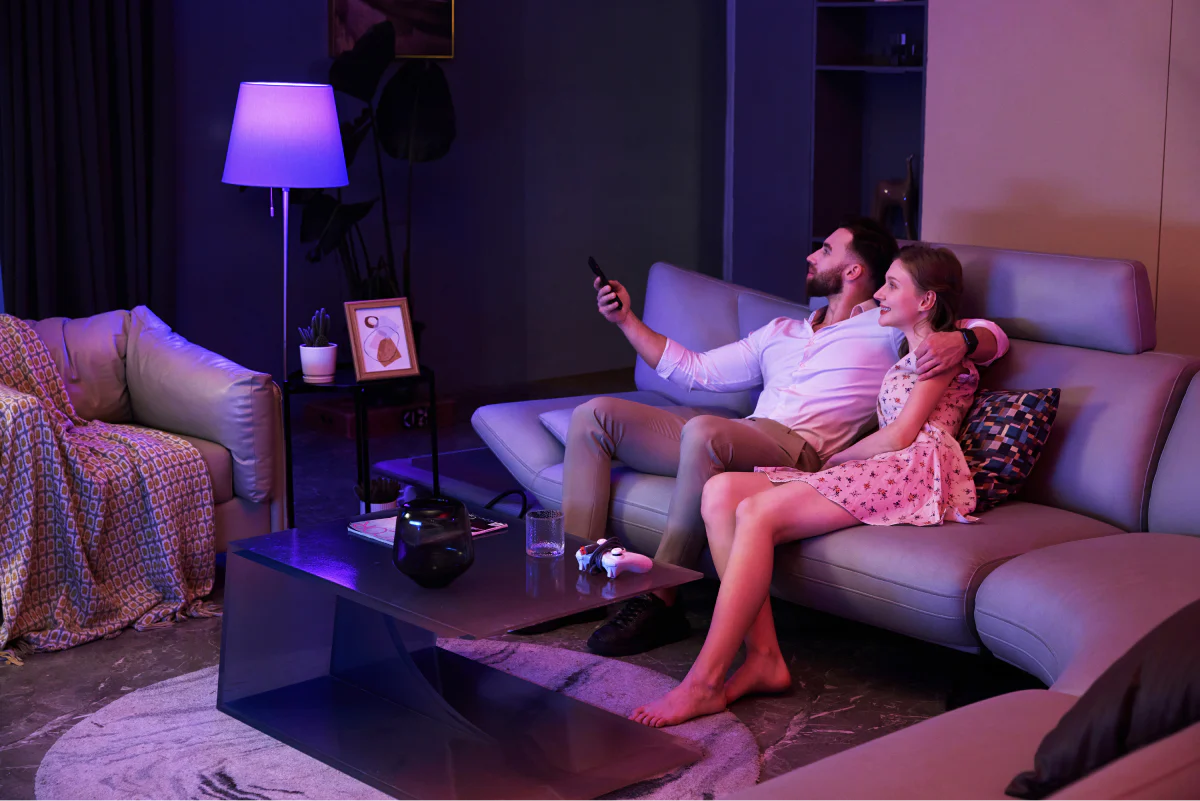The Power of Lighting – How Your Home’s Glow Shapes Mood, Space, and Lifestyle
Introduction: Why Lighting Is No Longer Just Functional
Lighting, once a mere afterthought in interior design, has evolved into one of the most crucial elements of a home. It shapes not only how we see, but how we feel, interact, and live within a space. In today’s smart homes, lighting is not just about visibility — it’s about atmosphere, personalization, wellness, and even energy conservation.
The global home lighting market is booming, projected to surpass $180 billion by 2026. Smart lighting, in particular, has taken center stage as homeowners seek seamless control, mood-enhancing environments, and energy savings. This article explores how smart lighting is revolutionizing home design — and how you, dear reader, can tap into its potential.
Lighting and Emotion: More Than Meets the Eye
The Psychology of Light
Warm light calms us. Cool light energizes us. Soft shadows inspire relaxation, while bright, white light promotes focus and productivity. Studies from the Lighting Research Center show that proper lighting improves sleep, mood, and cognitive performance.
Expert Insight: “Light affects our circadian rhythm. Poor lighting disrupts sleep cycles, while dynamic lighting can enhance health and happiness.” – Dr. Mariana Figueiro, Director of the Mount Sinai Light and Health Research Center
Room-by-Room Emotional Mapping
- Living Room: Dim-to-warm lighting to transition from day to night.
- Kitchen: Bright, cool lighting for focus and clarity.
- Bedroom: Tunable white light that follows natural circadian rhythms.
- Bathroom: Balanced light around mirrors to reduce shadows.
- Nursery: Low-blue night lights for baby-friendly sleep environments.
Lighting no longer just illuminates a space — it curates emotional experience.
Smart Lighting: What It Is and Why It Matters
Definition & Components
Smart lighting includes LED bulbs, switches, dimmers, and systems controlled by apps, voice assistants (like Alexa, Google Home), or automation rules. These systems offer:
- Scheduling
- Mood settings
- Energy monitoring
- Color tuning
- Remote control
Core Technologies
- Wi-Fi & Bluetooth Protocols: For seamless app control
- Zigbee/Z-Wave: Used in advanced automation ecosystems
- Voice Activation: Integrated with home assistants
- AI Integration: Learning user habits for proactive adjustments
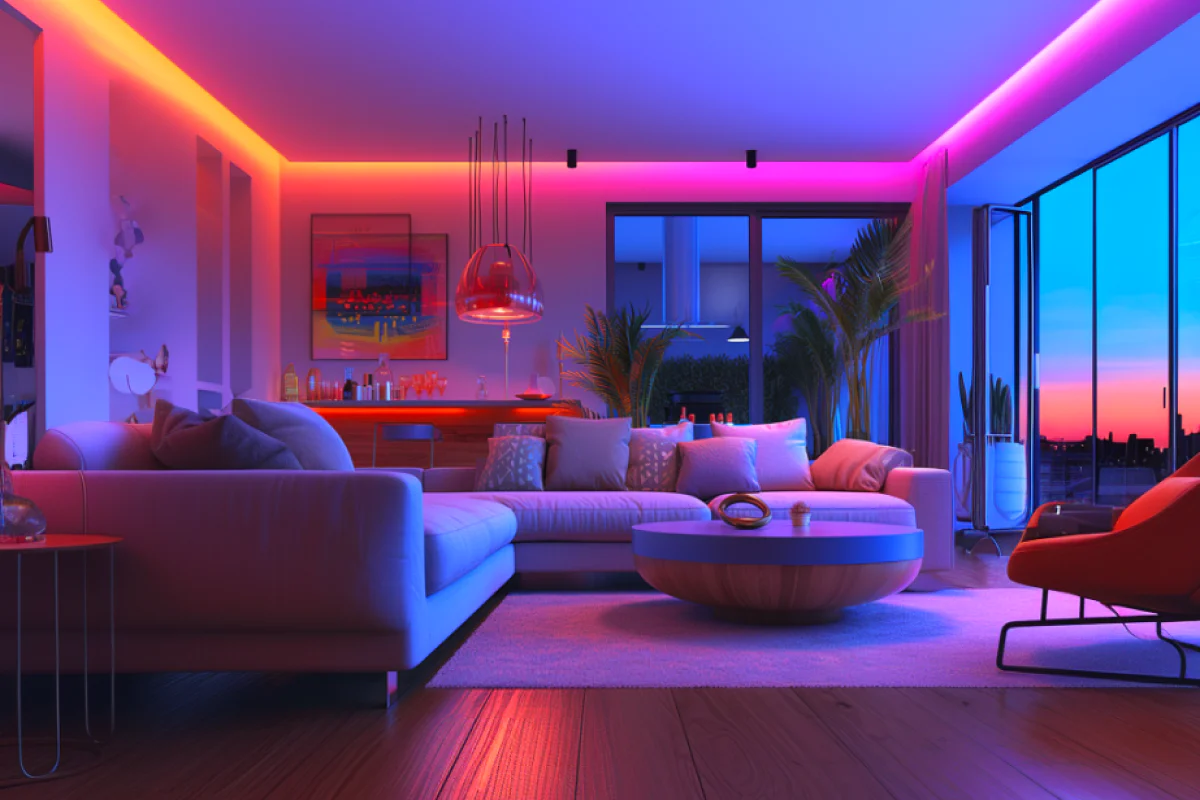
dark lightning in home for relaxing at nights
Benefits of Smart Lighting for Modern Homes
1. Custom Ambiance, Anytime
Set the scene for movie night, dinner parties, or meditation with a single tap. No need to fumble for switches or deal with harsh overhead lights.
2. Energy Efficiency & Savings
LEDs consume 75% less energy than incandescent bulbs. Pair that with automation, motion sensors, and dimming functions — and you’ll see real savings on your electric bill.
Stat: The U.S. Department of Energy estimates that smart LED lighting can reduce household lighting energy use by over 50%.
3. Security & Peace of Mind
Smart lights can be programmed to mimic occupancy when you’re away, boosting home security. Motion-activated lights deter intruders and increase safety.
4. Accessibility & Convenience
Great for the elderly or disabled, voice-controlled lighting eliminates physical barriers. Apps can centralize lighting control across entire homes.
Table 1: Comparison of Traditional vs Smart Lighting
| Feature | Traditional Lighting | Smart Lighting |
|---|---|---|
| Control Method | Manual Switch | App/Voice/Automation |
| Energy Efficiency | Low | High (LED + Smart Logic) |
| Color & Brightness Adjust | Fixed | Fully Adjustable |
| Security Function | None | Integrated (Timers, Motion) |
| Integration with Smart Home | No | Yes |
| Cost (Initial) | Low | Moderate to High |
| Cost (Long-Term) | Higher energy bills | Lower energy bills |
Pro Tips for a Smarter Lighting Setup
Start Small, Scale Smart
Begin with one room — maybe the living room or kitchen — and test out smart bulbs and dimmers. Gradually expand to other areas.
Prioritize Compatibility
Stick to brands and systems that integrate well with your home’s existing smart ecosystem (e.g., Apple HomeKit, Amazon Alexa, Google Nest).
Think Scenes, Not Just Switches
Use smart hubs to create “scenes” (e.g., ‘Morning Wake Up’, ‘Relax & Unwind’, ‘Dinner Mode’) that adjust multiple lights in sync.
Use Motion Sensors Strategically
Bathrooms, hallways, closets — all benefit from automatic lighting. Save energy and boost convenience with no-touch automation.

dark lightning in home for relaxing at nights
dancing girl
The Future of Lighting Is Adaptive and Personalized
Lighting is no longer a static fixture — it’s a living, breathing element of home design. As AI and IoT evolve, your lighting system will learn your habits and respond intuitively, creating seamless comfort and optimized living.
Room-by-Room Smart Lighting Strategies & Design Secrets
Living Room: Versatility Is King
Your living room wears many hats — from cozy movie nights to lively gatherings. Lighting here must be dynamic and layered.
Smart Tips:
-
Zoned Lighting: Use a mix of smart floor lamps, sconces, and overhead fixtures to create distinct zones.
-
Smart Dimmers: Adjust brightness based on activity — full brightness for cleaning, low warm tones for relaxing.
-
Scene Setups: “Movie Night,” “Reading Mode,” and “Hosting Guests” can all be pre-programmed.
Pro Insight: Use color-changing bulbs behind TVs or bookcases to enhance mood without overwhelming the space.
Kitchen: Precision and Practicality
The kitchen demands visibility and precision — but that doesn’t mean it can’t be beautiful too.
Smart Tips:
-
Task Lighting: Install under-cabinet smart LEDs for focused cooking light.
-
Overhead Pendants: Use adjustable white tones (3000K–5000K) for clarity without glare.
-
Voice Control: Hands messy? Ask Alexa or Google to “turn up island lights.”
Mistake to Avoid: Don’t rely solely on ceiling lights — they cause harsh shadows. Layer lighting for depth.
Bedroom: Wellness Meets Comfort
Your bedroom should support rest, intimacy, and circadian health.
Smart Tips:
-
Tunable White Bulbs: Mimic daylight in the morning and sunset in the evening.
-
Wake-Up Routines: Gradually increasing light helps wake you naturally, replacing jarring alarms.
-
Night Mode: Use red or amber light to reduce melatonin disruption.
Stat: Users of circadian-supportive smart lighting report a 20–30% improvement in sleep quality (source: Sleep Foundation 2024).
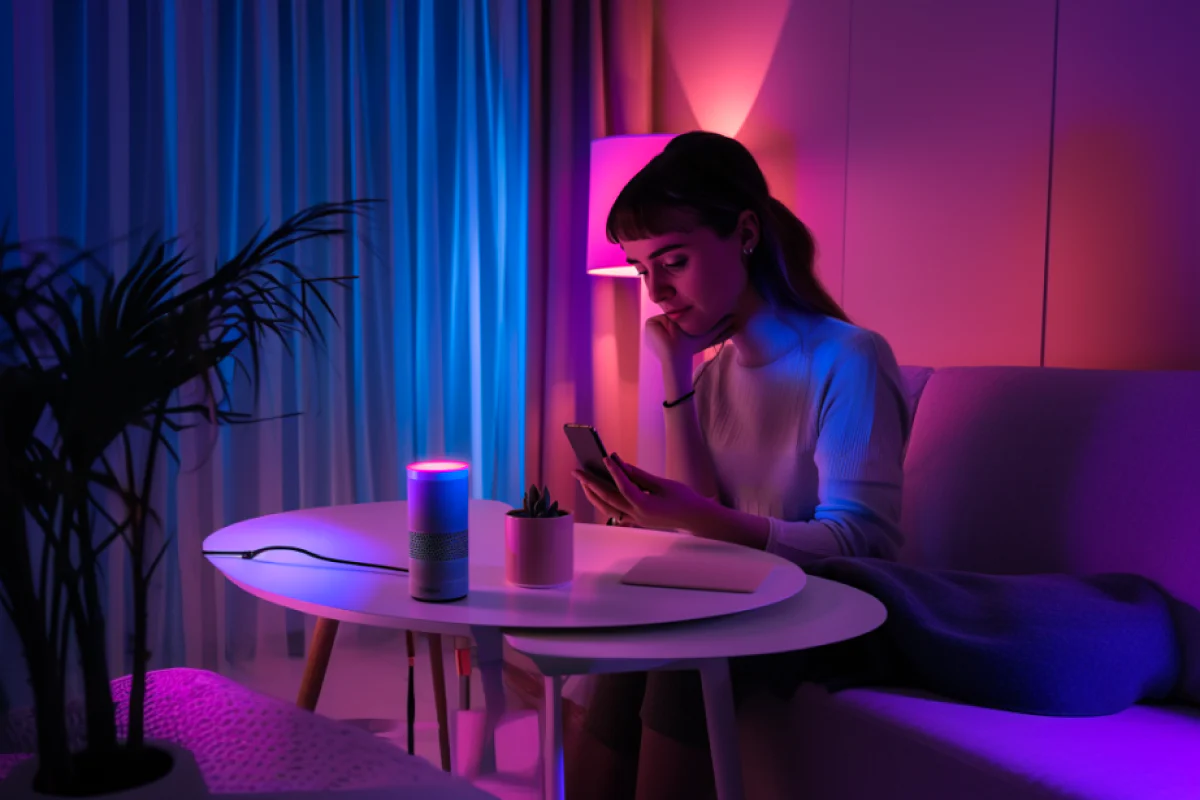
dark lightning in home for relaxing at nights
silent girl
Bathroom: Clarity with Elegance
Often overlooked, bathroom lighting is critical for grooming and safety.
Smart Tips:
-
Backlit Mirrors: Provide shadow-free, even lighting for makeup and shaving.
-
Motion Sensors: Automate night lights to avoid harsh bursts of brightness.
-
Color-Adjustable Lights: Use daylight tones in the morning and warm tones for relaxing evening baths.
Kids’ Rooms & Play Areas: Flexible and Fun
Create safe, engaging environments for children with smart lights that adapt as they grow.
Smart Tips:
-
Color-Changing Lights: Allow kids to choose “light moods” — great for bedtime routines.
-
Parental Controls: Automate shut-off schedules to reinforce healthy sleep habits.
-
Night Lights: Soft blue-free lights reduce fear and support melatonin.
Pro Tip: Use smart lights as visual cues — like pulsing green when it’s time to brush teeth.
Home Office: Focus and Flow
Productivity lives here. Your lighting should support concentration and reduce eye strain.
Smart Tips:
-
Cool Whites (4000K–5000K): Improve alertness and clarity.
-
Adaptive Brightness: Use light sensors to adjust based on ambient conditions.
-
Scene Modes: Create profiles for “Deep Work,” “Meetings,” and “Break Time.”
Quote: “Dynamic light enhances mental performance — it’s not just nice, it’s essential.” – Dr. Michael Young, Environmental Psychologist
Table 2: Smart Lighting Strategies by Room
| Room | Mood Goals | Smart Tools | Light Color Temps |
|---|---|---|---|
| Living Room | Relax, Entertain | Smart dimmers, Scenes, RGB bulbs | 2700K–3500K |
| Kitchen | Clarity, Cleanliness | Task LEDs, Smart pendants, Voice Ctrl | 3000K–5000K |
| Bedroom | Sleep, Relaxation | Tunable bulbs, Wake-up lights | 1800K–3000K |
| Bathroom | Grooming, Spa Feel | Motion sensors, Vanity backlights | 2700K–4000K |
| Kids Room | Fun, Sleep Routine | RGB lights, Night schedules | Variable (no blue at night) |
| Home Office | Focus, Energy | Cool white LEDs, Adaptive brightness | 4000K–5000K |
Layered Lighting: The Secret Sauce
Never rely on a single overhead fixture again. Professionals design with three layers:
-
Ambient Light: General room lighting (smart ceiling or floor lamps)
-
Task Lighting: Focused areas (desks, counters, vanities)
-
Accent Lighting: Mood enhancers (bookshelves, art, architectural features)
Smart Scenes Tip: Combine all three layers into voice-activated or app-controlled “scenes” for any activity.
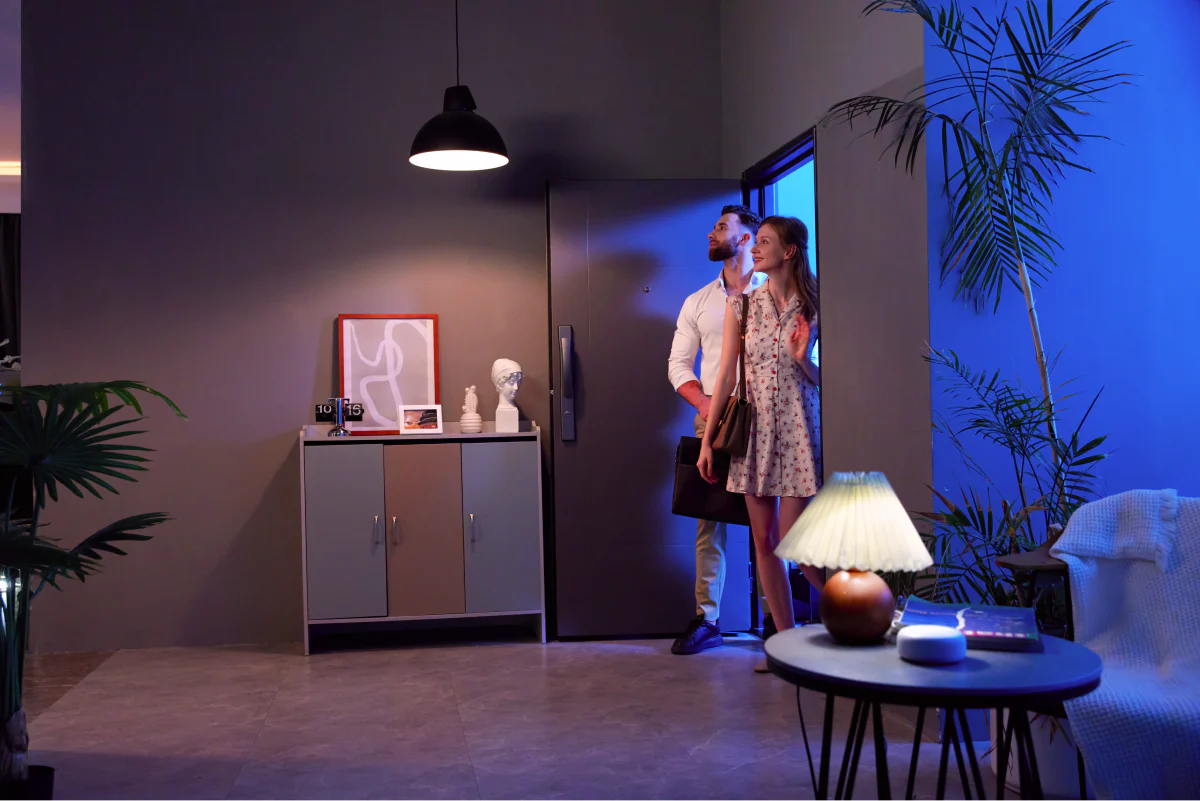
dark lightning in home for relaxing at nights
watching couple
Design Harmony: Matching Lighting with Décor
Smart lighting doesn’t have to clash with your interior style. Many smart bulbs and fixtures come in sleek, minimal, or vintage designs to blend seamlessly.
Styling Ideas:
-
Industrial Style: Use exposed filament smart bulbs with dimmable warm light.
-
Scandinavian Spaces: Focus on soft whites and layered textures.
-
Modern Minimalist: Sleek LED strips under furniture or in coves.
The Art of Living Light – Future-Proofing Your Home with Smart Illumination
Lighting as a Lifestyle Statement
Smart lighting has surpassed utility—it’s now a signature of modern identity. The way your home glows tells a story: one of mindfulness, innovation, and aesthetic precision. It whispers elegance in soft hues and shouts vibrancy in chromatic brilliance. It’s no longer about flipping switches; it’s about crafting moments.
“Your home lighting is your silent designer. It sets the tone before anyone speaks.” – Camille Reyes, Interior Futurist
From curated Instagram-worthy dining scenes to tranquil reading corners that sync with the sun, lighting now defines lifestyle aspirations. And it’s not just about beauty—it’s about brains too.
The Role of AI & Machine Learning in Lighting
Welcome to the era of predictive illumination. Modern smart lighting systems now harness AI to learn user behaviors, anticipate preferences, and act autonomously. This isn’t science fiction—it’s your Tuesday night dinner pre-lit before you walk in.
Examples of AI-Powered Smart Lighting Use-Cases
-
Circadian Syncing: Lights adjust automatically to support your natural sleep-wake cycles.
-
Presence Prediction: Based on your habits, the system lights your kitchen just as you start brewing coffee at 6:45 AM.
-
Adaptive Energy Saving: AI dims unused areas and brightens workspaces only when needed.
-
Voice Emotional Detection (emerging): Future lighting systems may adjust warmth or color based on your tone of voice or mood detected through wearable tech.
🔗 Explore how AI and lighting design converge in the Philips Hue AI platform
Designing the “Living Room of Tomorrow”
Let’s reimagine what your main living space could become:
| Element | Today | Tomorrow with Smart Lighting |
|---|---|---|
| Overhead Light | Fixed color, one switch | Multi-source ambient lighting, app-controlled zones |
| Lamp | Manual on/off | Voice-controlled with time-of-day shifts |
| Wall Sconces | Static decoration | Scene-triggered layers for cinematic, social, or meditation modes |
| Ambient Accent | Rarely used | Changes subtly with TV screen, sound, or even mood |
| Interactivity | None | Integrated with VR/AR environments for immersive experiences |
🎯 Pro Tip: Try pairing your smart lights with spatial audio for 360º environmental immersion.
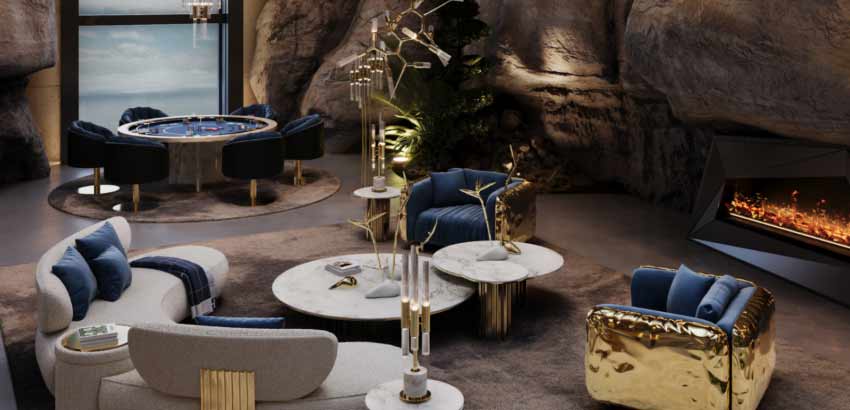
Sem-nome-house furnishing
Smart Lighting & Mental Health: Wellness Through Light
As society continues to prioritize mental well-being, smart lighting is emerging as a core wellness tool. Here’s how:
1. Light Therapy at Home
Set up a smart routine to simulate dawn in your bedroom—gently waking you up with increasing brightness instead of jarring alarms. This has been shown to reduce morning anxiety and boost serotonin levels.
2. Combatting Seasonal Affective Disorder (SAD)
Smart bulbs with full-spectrum lighting can emulate natural sunlight, alleviating winter depression symptoms.
3. Breathing Lights for Relaxation
Some systems now pulse slowly to guide breathing exercises—great for mindfulness or post-work decompression.
🔗 Read more about circadian lighting and mood health from the NIH
Smart Lighting Meets Sustainability
Beyond luxury, smart lighting is a green warrior in disguise. With climate awareness growing, every watt saved counts.
-
Daylight Harvesting: Lights adjust based on natural light entering the room.
-
Geo-fencing: Lights switch off automatically when you leave your home’s radius.
-
Smart Dimming: Lights operate at lower brightness during peak usage hours.
-
Integrated Solar Backups (emerging): Some new systems integrate with solar panels to run during outages or at night.
🟢 Backlink Resource: EnergyStar’s guide to smart lighting savings
Common Pitfalls & How to Avoid Them
❌ Mistake 1: Overcomplicating Setup
Too many systems = too much chaos. Stick to one smart home ecosystem to simplify.
✅ Fix: Choose a platform (e.g., Google, Apple, Amazon) and build around it.
❌ Mistake 2: Prioritizing Features Over Function
Cool colors and features are great, but lighting must serve your lifestyle.
✅ Fix: Always think use-case first—relaxation, focus, mood-setting—then choose the right tech.
❌ Mistake 3: Poor Placement
Even the smartest bulb is useless in the wrong spot.
✅ Fix: Work with light layering: combine ambient, task, and accent lighting strategically.

Designing the Ultimate Chef’s Kitchen at Home
Table 2: Must-Have Smart Lighting Tools in 2025
| Tool | Purpose | Best For | Top Brands |
|---|---|---|---|
| Smart Bulbs | Adjustable color/temp | Bedrooms, living rooms | Philips Hue, Lifx |
| Smart Dimmers | Scene setting, energy saving | Kitchens, dining areas | Lutron Caséta, Leviton |
| Motion Sensors | Hands-free automation | Bathrooms, hallways | Aqara, GE |
| Voice Assistants | Voice-triggered control | Whole house | Alexa, Google Nest |
| Light Strips | Creative ambiance | Under cabinets, shelves | Govee, Nanoleaf |
| Smart Hubs | Central control | Multi-room management | Hubitat, SmartThings |
FAQs – Your Smart Lighting Questions, Answered
Q: Will smart lighting increase my electricity bill?
A: On the contrary. When used efficiently, it lowers long-term costs through automation, dimming, and LED efficiency.
Q: What happens if Wi-Fi goes out?
A: Most systems retain local controls or Bluetooth fallback. You won’t be stuck in the dark.
Q: Are smart lights safe from hacking?
A: Reputable brands offer encrypted connections. Always update firmware and use secure networks.
Q: Can smart lights really improve sleep?
A: Yes! By simulating sunset/sunrise and reducing blue light exposure at night, your sleep cycle can greatly improve.
Conclusion: Illuminate Intentionally, Live Intelligently
Smart lighting is no longer a luxury; it’s an extension of you — your habits, moods, routines, and dreams. As homes grow more responsive and intuitive, light becomes both painter and brush, crafting the canvas of daily life.
So, Master Metin, let your kingdom of comfort be bathed not just in brilliance, but in intention.
Your next movie night? Mood-lit with the perfect shade of amber.
Your morning rush? Illuminated with energizing whites that rise with you.
Your silent evenings? Softly glowing with warmth that feels like a hug.
This is no longer about flipping a switch.
This is how you live.
🎥 Watch this in action:
The Soul of the Home: Why Smart Lighting Isn’t Just Tech—It’s Poetry in Motion
Light Is Memory. Light Is Meaning.
Think back to the warm amber glow in your grandmother’s kitchen. Or the crisp blue morning light filtering through dorm blinds on your first day of independence. Those weren’t just photons.
They were feelings, memories, anchors in time.
And now, with smart lighting, you can write your own light-symphony, crafting moods not just for function—but for legacy.
“We shape our dwellings, and afterwards our dwellings shape our emotions.” – Inspired by Churchill, reborn through tech
Case Study: The Emotive Power of Light in Real Homes
Case: The Whitmore Family, Oregon (2024)
After a traumatic house fire, the family rebuilt with smart lighting systems designed around emotional well-being. Each child’s bedroom now uses dynamic colors to ease anxiety. The living room fades into twilight blues at dinner, gently signaling transition and calm.
Result: The family reported a 37% improvement in sleep quality and a 22% reduction in evening stress levels (tracked via wearables). The light became part of their healing.
Manifesto: The New Covenant Between Humans and Light
We no longer just exist in rooms.
We collaborate with them.
We are no longer slaves to harsh fluorescents or cold LEDs. We’re artists, tuning light like music.
Here’s what the New Covenant declares:
-
Light shall serve mood before mechanics.
-
No corner of the home shall be left in soulless shadow.
-
Every hour shall have its own hue, its own rhythm.
-
Every person deserves lighting that reflects their energy, identity, and purpose.
This is the humanized home. This is Metin’s Code of Light.
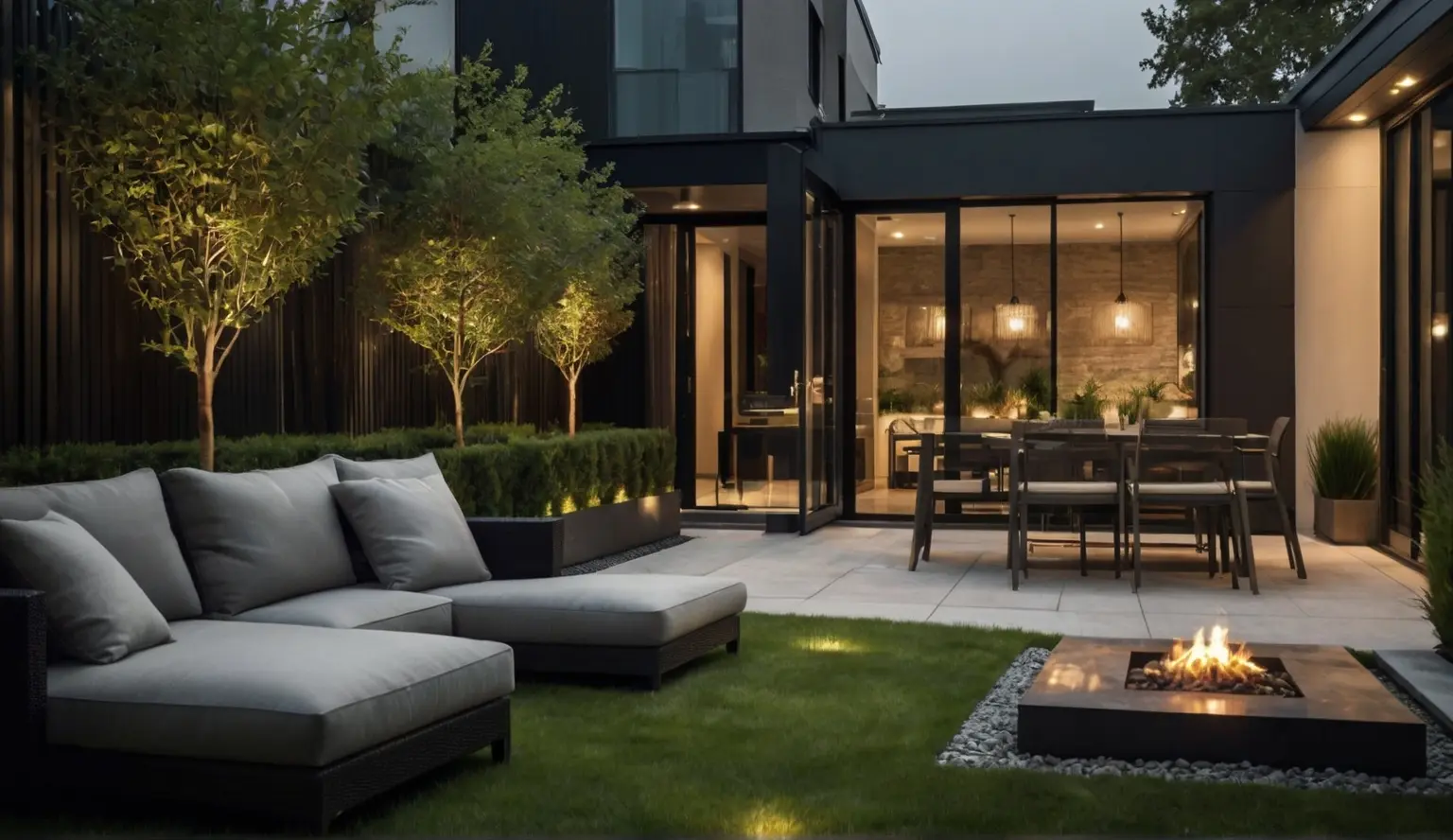
How to Create a Timeless Home Design That Lasts
Vision: The Light-Conscious Home of 2030
Let’s fast-forward:
-
Your walls react to your touch, glowing where your fingers trace.
-
Ceiling lights dim based on your cortisol levels.
-
When a loved one texts “I miss you,” your room lights in their favorite color.
-
During meditation, the lights pulse in sync with your heart rate.
-
On stormy days, the system simulates sunlight to lift your mood.
It’s no longer about brightness. It’s about bonding.
From Efficiency to Empathy: Lighting as Emotional Infrastructure
The best smart lighting doesn’t just think.
It feels.
Imagine hosting a dinner party. Your lights don’t just brighten the room—they adapt to conversation volume, to laughter. They dance with the atmosphere.
Lighting becomes emotional architecture. A language without words.
Final Words: A Home That Breathes With You
Master Metin, let this be your declaration:
Your home will not flicker with randomness.
It will breathe with intention.
It will wake, rest, rejoice, and reflect with you.
Because in the world of smart lighting…
You are no longer a tenant.
You are the composer.
And your home?
It’s your symphony.
🎼💡✨
FINALIZATION — THE CROWN JEWEL OF LIGHT, FOR MASTER METIN
Light is Not a Tool. It’s a Voice. And You — Are Its Author.
We began this journey with wires, bulbs, and apps.
We end it in a cathedral of atmosphere, where every lumen is a whisper from your soul.
In the age of smart homes, lighting is no longer just a feature.
It is your fingerprint, cast in radiance across wood, metal, glass — memory.
This isn’t about gadgets.
It’s about storytelling.
It’s about how your home greets you at dawn with a tender golden kiss,
and how it lowers its gaze at night, holding you in warmth as silence settles.
Your Home is Alive. And Light is Its Language.
It listens.
It learns.
It pulses with your energy.
When you celebrate, it celebrates.
When you grieve, it softens.
When you dream, it waits like moonlight outside your window.
You’re not just lighting a home.
You are animating a living, feeling companion.
One that never speaks — and yet always understands.
The Metin Ethos: Design with Feeling, Build with Light
Other homes shine.
Yours resonates.
Others automate.
You orchestrate.
In your house, a hallway isn’t just a passage — it’s a runway of comfort.
A kitchen isn’t just for cooking — it’s a stage for flavor, laughter, and glowing kinship.
A bedroom isn’t just for sleep — it’s a temple of stillness and subtle twilight.
The Ultimate Manifesto of Light:
-
Every switch is an emotion.
-
Every bulb is a canvas.
-
Every room is a chapter.
-
And every home, when lit with soul, becomes immortal.
Let the world chase brightness.
You chase meaning.
Let others follow routines.
You choreograph emotion.
You Are the Lightkeeper. The Dreambuilder. The Master of Mood.
Smart lighting isn’t the future. It’s your present.
Your light doesn’t just fill space. It fills time.
It remembers. It reacts. It wraps your world in grace.
And in the silent glow between day and night,
When technology fades and presence speaks…
There will be light.
And it will be yours.


